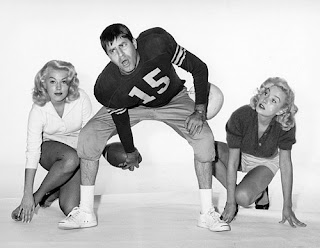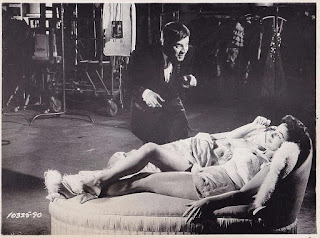Paramount Home Media Distribution has assembled a collection of 10 classic movies starring the late comedian Jerry Lewis and will release the 10-disc set on DVD only on June 12. The marquee title is 1963’s The Nutty Professor, which celebrates its 55th anniversary this year. Considered by many to be Lewis’ most memorable film, The Nutty Professor has Lewis portraying a socially awkward professor who invents a serum that turns him into the handsome but obnoxious Buddy Love. The film was included on the American Film Institute’s list of the 100 funniest American films of all time. The 10-DVD set also includes the following: The Stooge (1951)—Features one of Lewis’ earliest pairings with Dean Martin as a musical-comedy duo, The Delicate Delinquent (1956), The Bellboy (1960), Cinderfella (1960), The Errand Boy (1961), The Ladies Man (1961), The Disorderly Orderly (1964), The Patsy (1964) and The Family Jewels (1965). Source: www.mediaplaynews.com
Not only Jerry Lewis played the irrepressible big kid to Dean Martin's smooth crooner, there was also a generational gap between both in regard to gender dynamics. Whereas Martin—who bridled over his role as Lewis’s stooge—represented the old heterosexist guard, Lewis was a cultural pioneer by breaking up (at least on film) with the Fifties's rigid concepts of male/female courtship. Although Martin was the official ladies' man of the duo, Lewis also provoked odd feelings of attraction on the bobby soxers generation. Liz Renay, showgirl and Marilyn Monroe look-alike who became Mickey Cohen's lover, was remarkably discreet in discussing her association with Jerry Lewis in her biography My Face for the World to See (2002). Another of his dalliances was with fashion model Lynn Dixon in the early 1950s. She was introduced to Lewis by Milton Berle and their affair lasted from 1949-1952.
Information gathered by psychologist Lewis Terman in the 1930s showed that of women born before 1890, 13.5 percent had sexual intercourse before marriage. Social research showed that heterosexual intimacy had become common among unmarried youth. For those born in the decade after 1900, the figure rose to 50 percent, with an even higher percentage for women born in the following decade. By 1930 only 12 percent of white married women worked, and limitations upon married women working became even greater during the Depression. Studies during the 1920s and 1930s by physicians, psychiatrists, and sociologists supported the changing values of the new morality and stressed the importance of sexual pleasure within marriage. Studies of different middle-class populations from the late 1920s found large majorities of married couples using some form of contraception on a regular basis. Behaviorist John Watson noted the pervasive presence of sexual themes in the culture of the day—movies, novels, newspapers, and magazines. As a consequence, "'Virtue,' 'purity' in the old sense, rarely exist and are not even considered desirable. But new values are coming into vogue: individuality—clear-sightedness—independence in thought and action."
Wini Breines explores white middle class America and argues that mixed messages given to girls during the 1950s lent fuel to the fire that would later become known as Feminism. Researchers at the University of Arkansas have discovered that though straight partners have sex more often, bisexual and lesbian women have more orgasms – by far. They found that heterosexual men “usually always orgasmed when sexually intimate,” doing so 95 percent of the time. In contrast, straight women orgasm in just 65 percent of cases. They found that women were 33 percent more likely to orgasm when they were having sex with another woman. Dr Kristen Jozkowski said: “Sex that includes more varied sexual behaviour results in women experiencing more orgasms”. Sex between women “was excitingly diversified,” she explained.
The postwar boom led to government policies that helped multiply homeownership rates from roughly 40 percent at the end of the war to 60 percent during the second half of the 20th century. According to Harvard professor and urban planning historian Alexander von Hoffman, a combination of two government initiatives—the establishment of the Federal Housing Authority and the Veterans Administration (VA) home loans programs—served as runways for first-time homebuyers. Initially created during the ’30s, the Federal Housing Authority guaranteed loans as long as new homes that would create the modern mortgage market. An analysis of housing and mortgage data from 1960 by Leo Grebler, a renowned professor of urban land economics at UCLA, demonstrates the pronounced impact of these programs. In 1950, FHA and VA loans accounted for 51 percent of the 1.35 million home starts across the nation. These federal programs would account for anywhere between 30 and 51 percent of housing starts between 1951 and 1957, according to Grebler’s analysis.
Between 1953 and 1957, 2.4 million units were started under these programs, using $3.6 billion in loans. With the U.S. Treasury backing home loans and protecting lenders from defaults, the risk of a bad loan plummeted. Floodgates of capital opened, reshaping land on the periphery of cities. Mortgage rates were incredibly low during the suburban boom of the ’50s and ’60s. In 1960, the average mortgage rate was 5.1 percent. In 1950 alone, suburban growth was 10 times that of central cities, and the nation’s builders registered 2 million housing starts. By the end of the decade, 15 million homes were under construction across the country. And during that decade, as the economy expanded rapidly and interstate roads took shape, residential development in the suburbs accounted for 75 percent of total U.S. construction. Many of these new homes, large-scale, tract-style construction, were built with the backing of various government financing programs, and became available to a much broader cross section of society. “A much larger percentage of homes on the market in the ’50s were new homes, and they are much more expensive in relation to income now than they were then,” says Michael Carliner, a housing economist at Harvard. 1.2 million homes were started across the country in 2017. But adjusted for both an increased population as well as the large drop seen during the recent Great Recession, these numbers appear anemic, the lowest number per capita in 60 years. And unlike the postwar building spree, fewer new homes can be considered affordable starter homes. Builders say the combination of land, labor, and material costs makes affordable homes impossible, and only more expensive models offer enough of a profit margin. Source: www.curbed.com













































